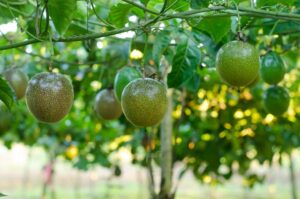
The passionfruit vine (Passiflora edulis) is a vigorous perennial woody evergreen fruiting subtropical vine from the Passifloraceae family. It has three-lobed, glossy green leaves, and climbs by tendrils, reaching a height of up to 5m (15′), depending on the structure it’s climbing upon.
The purple fruiting variety of passionfruit vines (Passiflora edulis f. edulis) originate from subtropical South America, and are native to the region that spans from southern Brazil to northern Argentina, whereas the origins of the yellow passionfruit (Passiflora edulus f. flavicarpa) are unclear, it’s also believed to have originated in Amazonian Brazil.
Passionfruit Flowers and Pollination
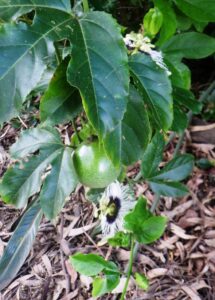
Passionfruit vines are short-lived, living only for around six years, and produce flowers at maturity, which can take about 6 months to a year. The unique and exotic flowers of edible passion fruit vines are purple and white in colour, and around 7-12cm (3-5″) wide. They appear in summer and early autumn, and only last for around a day.
Note: Other species of passionfruit produce different coloured flowers. The edible banana passionfruit (Passiflora mollissima) for example produces pink or pink-purple flowers and elongated, yellow to orange, fuzzy skinned fruit resembling a banana. Other edible and non-edible Passiflora species can produce a range of coloured flowers including blue, purple, yellow, red, white and pink.
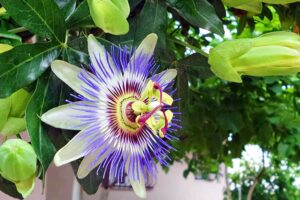
The flowers have a complex anatomy with a central reproductive structure (the stigma and anthers) surrounded by a ring of filaments and petals, and are unique in that they rely on large solitary bees known as carpenter bees (Xylocopa species) for pollination.
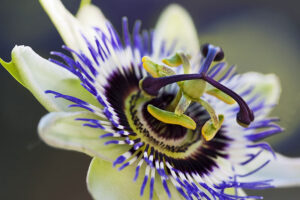
These bees are attracted to the flower’s fragrance and nectar, and use their powerful jaws to vibrate and shake the central reproductive structure which releases pollen onto the bee, which it then transfers to other flowers, pollinating them.
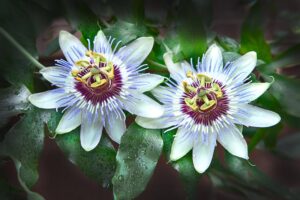
In areas where carpenter bees aren’t present, pollination is mainly carried out by honeybees.
Passionfruit Harvesting and Use
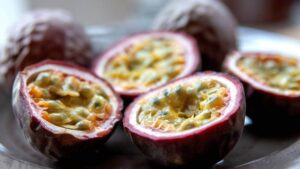
Once the flowers of the passionfruit vine have been pollinated, it takes around 70–80 days for the tasty fruit to form and ripen. Once fruit grows to its full sized it can still take a while longer to ripen properly. The fruit will begin falling to the ground when ripe, so it’s best to check the vines every couple of days when fruit is turning it’s proper colour.
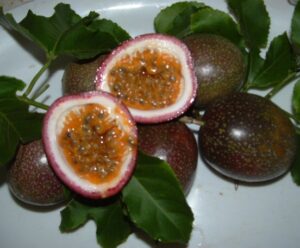
- The purple variety of passionfruit is round in shape and approximately 5-7cm (2-3″) long. When the fruit is ripe, the thick waxy rind becomes wrinkly, and deep purple in colour with faint white specks. The fruit contains an orange, juicy pulp inside with many small, dark, crunchy seeds.
- The yellow variety of passionfruit is usually larger in size with brown seeds, but the pulp inside isn’t as nice or juicy as that of the purple passionfruit.
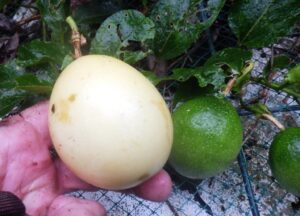
For those in cooler temperate climates, the purple passionfruit (often sold a black passionfruit) and the banana passionfruit grow well in such locations. The red-skinned and golden yellow hybrid varieties do better in the warmer climates, they fruit longer and produce more than the black varieties.
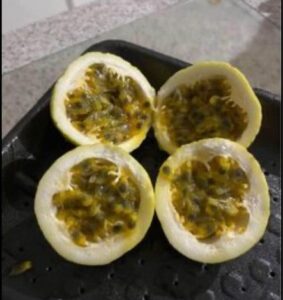
Passionfruit are considered a delicious, tasty fruit with a sweet, tart, aromatic flavour. When passionfruit is freshly picked, the skin is taut and shiny, and the flavour is refreshingly tart. As the fruit ripens, the skin shrivels over time, and it becomes sweeter and more complex in flavour, being described as a combination of citrus, melon, pineapple, and kiwi.
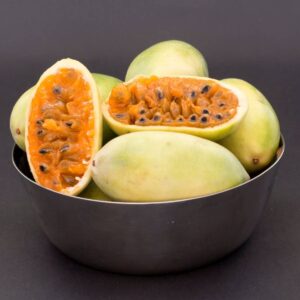
There are many ways to use passionfruit:
- The fruit is commonly eaten fresh by halving the fruit and scooping out the pulp and small seeds with a spoon.
- The pulp can be made into ice cream, or into syrup, which can be used as a topping for ice creams.
- It can be made into juices, and is a popular additive for drinks and alcoholic beverages.
- The pulp can also be used for making jams, and also used for a variety of deserts, from cakes and tarts to the meringue-based Pavlova.
Nutritional Value of Passionfruit
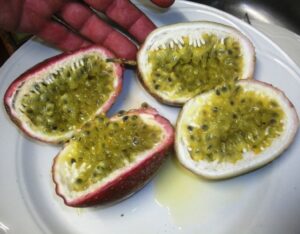
Passionfruit are very nutritious, and contain essential vitamins and minerals such as vitamin A, vitamin C, riboflavin, niacin, iron, potassium, zinc, and magnesium.
They’re high in potent antioxidant compounds such as:
- Vitamin C (ascorbic acid)
- Vitamin E (tocopherols)
- Carotenoids (alpha-carotene, beta-carotene, beta-cryptoxanthin, lutein, zeaxanthin, and lycopene). These are the yellow, orange and red plant pigments, of which the provitamin A carotenoids, α-carotene, β-carotene, and β-cryptoxanthin, can be converted by the body into retinol (vitamin A)
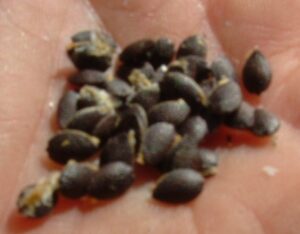
The seeds of passionfruit also contain an oil that is a good source of omega-3 and omega-6 essential fatty acids and large amounts of the antioxidant compound piceatannol (3,4,3′,5′-tetrahydroxy-trans-stilbene).
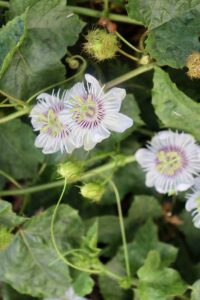
How to Grow Passionfruit Vines
By providing passionfruit vines with their preferred conditions, we can maximise plant growth and productivity while ensuring plant health.
Climate and Location
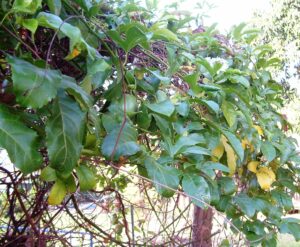
Passionfruit vines thrive in subtropical to tropical climates. The plants are sensitive to frost, so when grown in cooler temperate climates it’s essential to provide protection during colder months. Growing them against a wall, structure or paving that receives midday or afternoon sun provides a thermal mass that heats up during the day and releases the heat when the cooler night temperatures arrive, protecting them from cold.
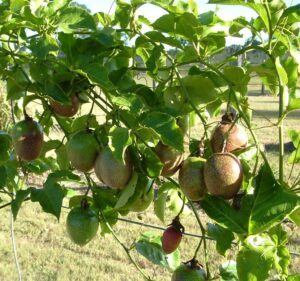
Being vigorous, climbing vines, passionfruit need some form of support to grow over such as a a sturdy trellis, pergola, arbor, or fence. Wires can be strung between posts or across fences, and wide mesh panels (with a 10cm (4″) mesh to fit your hands through) can be fastened to a fence for this purpose.
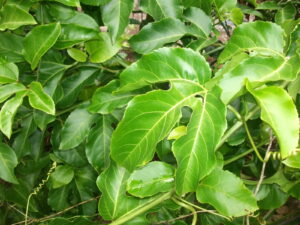
Water tanks provide good thermal mass which retains warmth. A simple support or trellis can be made using some sheets of reo-mesh (steel reinforcing mesh used for concrete) attached to steel post that create a screen that sits parallel to the sunny side of the water tank, around 50cm away to allow space to get behind it if necessary.
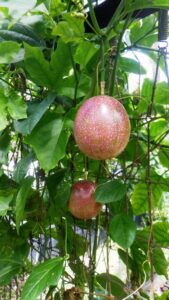
In Australia, passionfruit vines can also be grown in the cooler temperate climates which have Mediterranean weather. For US gardeners, they can be grown in USDA hardiness zones 9-11.
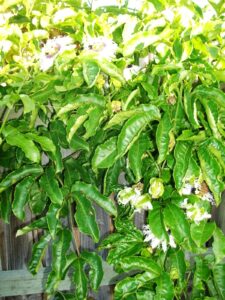
The planting location should provide some protection from harsh winds, a highly exposed location is not ideal for passionfruit vines.
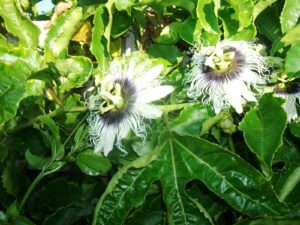
Passionfruit vines can be grown both in the ground and in large containers, such as a 40-50cm (16-20″) wide pot, making them versatile additions to gardens, patios, or even balconies.
When growing in the ground, use a plant spacing of 90-150cm (36-60″) between passionfruit vines.
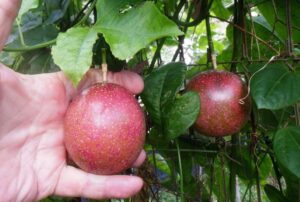
Sunlight Requirements
Passionfruit vines are sun-loving plants that require at least 6-8 hours of direct sunlight daily. They’re best planted in a location where they receive sufficient sun to grow well and ensure abundant fruiting. With increasing shade, less fruit is produced.
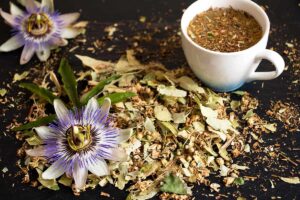
Passion fruit & leaves make a relaxing tea drink before bedtime
Soil and Feeding
The ideal soil for passionfruit vines is a fertile, well-draining soil with a slightly acidic to neutral pH. Passionfruit vines can grow in a range of soil types such as sand, loam or clay. Soil salt tolerance is poor, so avoid saline soils. Drought tolerance is only moderate, so these vines will require frequent watering, and infrequent or inadequate watering can lead to fruit drop. It’s important to keep in mind that passionfruit vines will only tolerate occasionally wet soils, and waterlogged clay soils can lead to root rot, especially during cold, wet temperate climate winters.
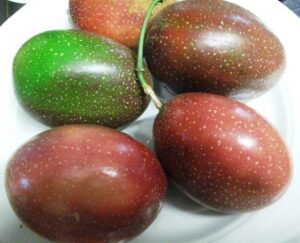
Improve the soil structure by digging compost into the soil, this will improve water and nutrient retention in fast-draining sandy soils and increase drainage in wet clay soils.
Enrich the soil with natural, slow release fertilisers such as animal and poultry manures or balanced organic fertiliser to improve fertility. Feed at the start of spring and autumn at a minimum, and regular feeding every two months during the growing season (between spring and autumn), promotes healthy foliage and robust fruit development.
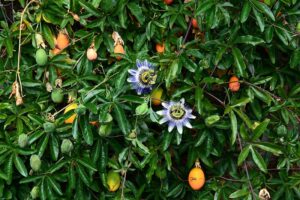
Follow the fertiliser application rate on the label, don’t use too much, as using excessive fertiliser will lead to plenty of green, leafy vegetative growth rather than the production of flowering and fruit. When using animal manures, which are high in nitrogen (for leaf growth) and phosphorus (for root growth), it’s best to add a source of potassium which supports flowering and fruiting, such as sulphate of potash (potassium sulphate), or seaweed extract. A potassium deficiency will also cause reduced flowering.
Pollination
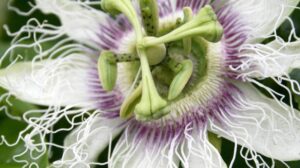
If there is insufficient cross-pollination by bees, the fruit may be incompletely filled with seeds and pulp. It’s possible to hand pollinate the flowers using clean gloves or a paint brush to transfer pollen from the anther (male part bearing pollen) of one flower to the stigma (female part in the centre) of another flower – not the same flower.
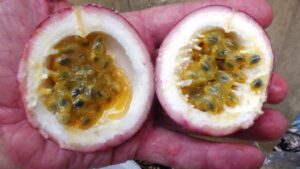
Each fertile seed within the fruit is produced when one embryo sac is fertilised by one pollen grain. The greater the degree of pollination, the greater the number of viable seeds within a fruit, which means the larger the fruit will be and the greater its juice content.
How to Prune Passionfruit Vines
Passionfruit vines are very vigorous, and will put on 3-4m (10-12′) of additional growth each year. Left unpruned they can easily take over a small garden space! Pruning passionfruit vines not only keeps them under control, it also renews the fruiting branches to keep them productive.
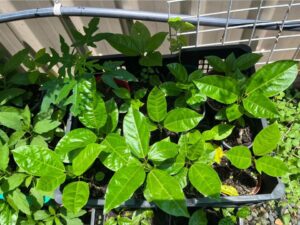
Basic Pruning
- One of the simplest ways to prune a passionfruit is to simply prune off at least 1/3 of the vine each year at the start of springtime.
Passionfruit produce flowers on new growth (new branches), so by pruning every spring we renew the fruiting wood.
Espalier Pruning
- A passionfruit vines can be espaliered – grow a single stem to the top of a wire, then prune the top so two lateral branches grow to create a T-shape.
- From 2nd year onwards, prune all branches coming off the laterals to short stubs with a few buds. They will regrow into new branches each year bearing the fruit.
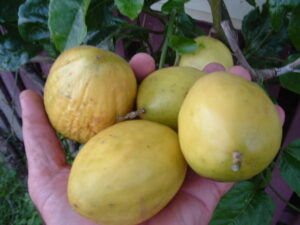
Detailed Pruning Procedure
Here’s a more detailed step-by-step guide on how to prune passionfruit vines:
1. Initial Training
- Begin pruning during the first year to encourage a strong framework. Select one or two main stems to train as the primary leaders. Remove competing shoots at ground level. If using grafted passionfruit vines, remove any growth originating below the graft.
- Provide a sturdy trellis or support structure for the vines to climb onto. As the main stems grow, tie them to the support to encourage upward growth.
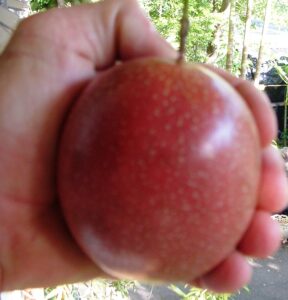
2. Regular Maintenance Pruning
- Remove Weak Growth – Periodically inspect the vine for weak or spindly growth. Prune away any stems that appear weak or diseased, as these can sap energy from the plant.
- Thin Out Overcrowded Areas – Passionfruit vines can become dense over time. Thinning out crowded areas allows better air circulation and sunlight penetration, helping with fruit ripening and reducing the risk of fungal diseases.
- Prune for Fruit Production – Encourage fruit production by selectively pruning back older wood that has already fruited to promote the growth of new fruit-bearing branches. Since passionfruit vines produce fruits on new growth, it’s important to identify and retain the healthy, vigorous new shoots which are a slightly different color and texture compared to older wood.
3. Renewal Pruning
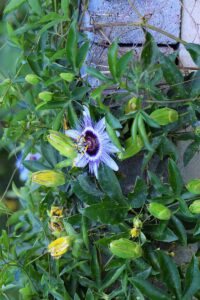
- Renew Older Vines – As passionfruit vines age, the older wood may become less productive. Periodically carry out renewal pruning by cutting back a portion of the older vines to stimulate new growth.
5. Post-Harvest Pruning
- After Fruit Harvest – Once the main fruiting season is over, conduct a post-harvest pruning. Remove any dead or unproductive growth and cut back overly long or unruly branches to maintain the desired shape. The vine will then regrow in spring producing more fruiting branches that will carry the next crop.
Should You Use Grafted Passionfruit Vines?
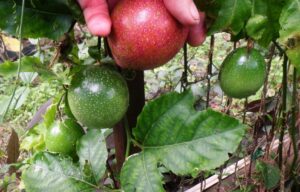
Passionfruit vines are sometimes grafted onto a rootstock of another type of passionfruit to create plants that are more resistant to pests and diseases, tolerate bad soil conditions better, and grow more vigorously.
The most common grafted passionfruit here in Australia are the ‘Nellie Kelly’ brand of passionfruit vines that are all grafted onto the non-edible blue passionfruit (Passiflora caerulea), which has five pointed leaves instead of the usual three-lobed leaves.
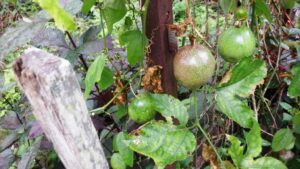
To quote the company, “Non-grafted Nellie Kelly vines are recommended for gardens with coarse or sandy soils (where grafted vines would be prone to suckering) and tropical areas where frost isn’t a problem.”
Grafted vines are prone to suckering, producing extremely vigorous shoots from the rootstock beneath the soil, which are very invasive and difficult to control. From experience, you’ll be uprooting them for a year or more!
If you see shoots from coming from the soil around a grafted passionfruit vine with five-pointed leaves, it’s an indication that the rootstock has taken over, using all the plant’s energy for growth, so the grafted vine at the top of the rootstock will not grow.
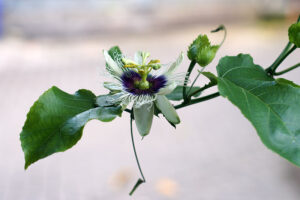
From the advice of the growers, don’t use grafted passionfruit vines in warmer climates, they’re not necessary. In cooler climates, only use them if you have perfect loose, friable loam soils – if you have sandy soils or heavy clay soils, which is the majority of areas in Australia, avoid grafted passionfruit vines because they will sucker and never grow into an edible vine. You’ll lose a year of growing and spend the next year after that trying to uproot the more vigorous, non-edible passionfruit vine suckers that will pop up weekly. Considering that passionfruit vines only live for 5-7 years, it’s simply not worth the risk. Use the ungrafted passionfruit vines instead, they’re simply grown from cuttings, are cheaper to purchase and are much easier to manage.
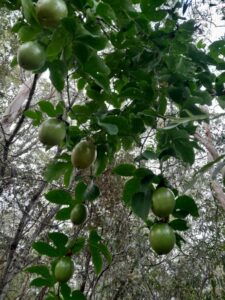
References
- HS1467/HS1467: The emerging passion fruit industry in Florida. (n.d.). Ask IFAS – Powered by EDIS. https://edis.ifas.ufl.edu/publication/HS1467
- FPS456/FP456: Passiflora edulis Passion Fruit. (n.d.). Ask IFAS – Powered by EDIS. https://edis.ifas.ufl.edu/publication/FP456
- Passion fruit. (n.d.). https://aihd.ku.edu/foods/PassionFruit.html
- Roos, D. (n.d.). Critter Spotlight: Passionflower Bee. NC State Extension. https://growingsmallfarms.ces.ncsu.edu/2023/08/critter-spotlight-passionflower-bee/
Please feel free to browse this site for passionfruit seeds & vines that I have on hand most of the time.Both Panama Red variety as well one we cal Hawaiian Gold passion fruit
 Any questions or if buying, contact me HERE
Any questions or if buying, contact me HERE

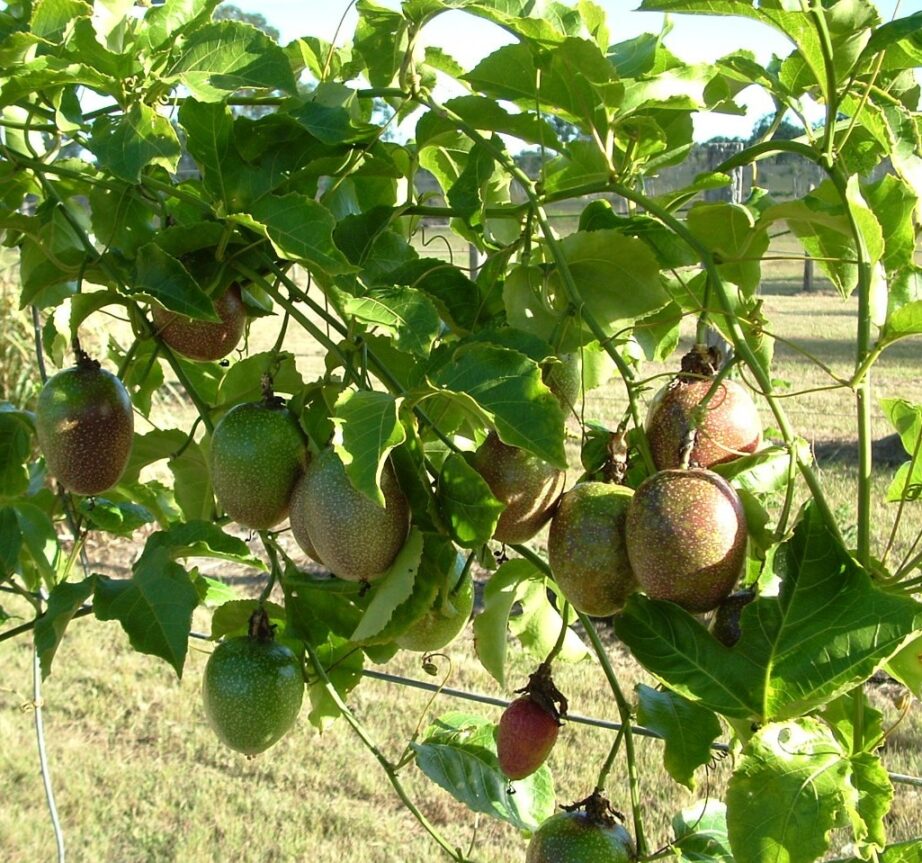
Recent Comments